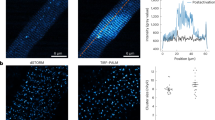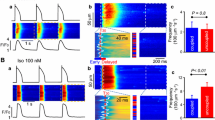Abstract
Protein complex of the cardiac junctional sarcoplasmic reticulum (SR) membrane formed by type 2 ryanodine receptor, junction, triadin, and calsequestrin is responsible for controlling SR calcium (Ca) release. Increased intracellular calcium (Cai) activates the electrogenic sodium–Ca exchanger current, which is known to be important in afterdepolarization and triggered activities (TAs). Using optical-mapping techniques, it is possible to simultaneously map membrane potential (V m) and Cai transient in Langendorff-perfused rabbit ventricles to better define the mechanisms by which V m and Cai interactions cause early afterdepolarizations (EADs). Phase 3 EAD is dependent on heterogeneously prolonged action potential duration (APD). Electrotonic currents that flow between a persistently depolarized region and its recovered neighbors underlies the mechanisms of phase 3 EADs and TAs. In contrast, “late phase-3 EAD” is induced by APD shortening, not APD prolongation. In failing ventricles, upregulation of apamin-sensitive Ca-activated potassium (K) channels (I KAS) causes APD shortening after fibrillation-defibrillation episodes. Shortened APD in the presence of large Cai transients generates late-phase 3 EADs and recurrent spontaneous ventricular fibrillation. The latter findings suggest that I KAS may be a novel antiarrhythmic targets in patients with heart failure and electrical storms.




Similar content being viewed by others
References
Baartscheer A, Schumacher CA, Belterman CN, Coronel R, Fiolet JW (2003) SR calcium handling and calcium after-transients in a rabbit model of heart failure. Cardiovasc Res 58:99–108
Bailie DS, Inoue H, Kaseda S, Ben-David J, Zipes DP (1988) Magnesium suppression of early afterdepolarizations and ventricular tachyarrhythmias induced by cesium in dogs. Circulation 77:1395–1402
Brugada P, Wellens HJ (1985) Early afterdepolarizations: role in conduction block, “prolonged repolarization-dependent reexcitation,” and tachyarrhythmias in the human heart. Pacing Clin Electrophysiol 8:889–896
Burashnikov A, Antzelevitch C (2003) Reinduction of atrial fibrillation immediately after termination of the arrhythmia is mediated by late phase 3 early afterdepolarization-induced triggered activity. Circulation 107:2355–2360
Castle NA, Haylett DG, Jenkinson DH (1989) Toxins in the characterization of potassium channels. Trends Neurosci 12:59–65
Chen PS, Antzelevitch C (2010) Mechanisms of cardiac arrhythmias and conduction disturbances. In: Valentin F, Richard AW, Robert H (ed) Hurst’s the heart. McGraw-Hill Professional, New York
Choi BR, Salama G (2000) Simultaneous maps of optical action potentials and calcium transients in guinea-pig hearts: mechanisms underlying concordant alternans. J Physiol 529(Pt 1):171–188
Choi BR, Burton F, Salama G (2002) Cytosolic Ca2+ triggers early after depolarizations and torsade de pointes in rabbit hearts with type 2 long QT syndrome. J Physiol 543:615–631
Chua SK, Chang PC, Maruyama M, Turker I, Shinohara T, Shen MJ et al (2011) Small-conductance calcium-activated potassium channel and recurrent ventricular fibrillation in failing rabbit ventricles. Circ Res 108(8):971–979
Damiano BP, Rosen MR (1984) Effects of pacing on triggered activity induced by early afterdepolarizations. Circulation 69:1013–1025
Davidenko JM, Cohen L, Goodrow R, Antzelevitch C (1989) Quinidine-induced action potential prolongation, early afterdepolarizations, and triggered activity in canine purkinje fibers. Effects of stimulation rate, potassium, and magnesium. Circulation 79:674–686
January CT, Chau V, Makielski JC (1991) Triggered activity in the heart: cellular mechanisms of early after-depolarizations. Eur Heart J 12(Suppl F):4–9
Koretsune Y, Marban E (1989) Cell calcium in the pathophysiology of ventricular fibrillation and in the pathogenesis of postarrhythmic contractile dysfunction. Circulation 80:369–379
Maruyama M, Lin SF, Xie Y, Chua SK, Joung B, Han S et al (2011) Genesis of phase 3 early afterdepolarizations and triggered activity in acquired long-qt syndrome. Circ Arrhythm Electrophysiol 4:103–111
Nagy N, Szuts V, Horvath Z, Seprenyi G, Farkas AS, Acsai K et al (2009) Does small-conductance calcium-activated potassium channel contribute to cardiac repolarization? J Mol Cell Cardiol 47:656–663
Ogawa M, Morita N, Tang L, Karagueuzian HS, Weiss JN, Lin SF et al (2009) Mechanisms of recurrent ventricular fibrillation in a rabbit model of pacing-induced heart failure. Heart Rhythm 6:784–792
Patterson E, Szabo B, Scherlag BJ, Lazzara R (1990) Early and delayed afterdepolarizations associated with cesium chloride-induced arrhythmias in the dog. J Cardiovasc Pharmacol 15:323–331
Patterson E, Lazzara R, Szabo B, Liu H, Tang D, Li YH et al (2006) Sodium–calcium exchange initiated by the Ca2+ transient: an arrhythmia trigger within pulmonary veins. J Am Coll Cardiol 47:1196–1206
Szabo B, Kovacs T, Lazzara R (1995) Role of calcium loading in early afterdepolarizations generated by Cs+ in canine and guinea pig Purkinje fibers. J Cardiovasc Electrophysiol 6:796–812
ter Keurs HE, Boyden PA (2007) Calcium and arrhythmogenesis. Physiol Rev 87:45–506
Volders PG, Vos MA, Szabo B, Sipido KR, de Groot SH, Gorgels AP et al (2000) Progress in the understanding of cardiac early afterdepolarizations and torsades de pointes: time to revise current concepts. Cardiovasc Res 46:376–392
Wang NC, Lee MH, Ohara T, Okuyama Y, Fishbein GA, Lin SF et al (2001) Optical mapping of ventricular defibrillation in isolated swine right ventricles: demonstration of a postshock isoelectric window after near-threshold defibrillation shocks. Circulation 104:227–233
Xu Y, Tuteja D, Zhang Z, Xu D, Zhang Y, Rodriguez J et al (2003) Molecular identification and functional roles of a Ca(2+)-activated K+ channel in human and mouse hearts. J Biol Chem 278:49085–49094
Yeh YH, Wakili R, Qi XY, Chartier D, Boknik P, Kaab S et al (2008) Calcium-handling abnormalities underlying atrial arrhythmogenesis and contractile dysfunction in dogs with congestive heart failure. Circ Arrhythm Electrophysiol 1:93–102
Zhang L, Kelley J, Schmeisser G, Kobayashi YM, Jones LR (1997) Complex formation between junction, triadin, calsequestrin, and the ryanodine receptor. Proteins of the cardiac junctional sarcoplasmic reticulum membrane. J Biol Chem 272:23389–23397
Zhang Q, Timofeyev V, Lu L, Li N, Singapuri A, Long MK et al (2008) Functional roles of a Ca2+-activated K+ channel in atrioventricular nodes. Circ Res 102:465–471
Acknowledgment
This study was supported in part by National Institutes of Health Grants no. P01 HL78931, R01 HL78932, and HL71140 as well as a Medtronic-Zipes endowment.
Author information
Authors and Affiliations
Corresponding author
Rights and permissions
About this article
Cite this article
Chen, PS., Ogawa, M., Maruyama, M. et al. Imaging Arrhythmogenic Calcium Signaling in Intact Hearts. Pediatr Cardiol 33, 968–974 (2012). https://doi.org/10.1007/s00246-012-0236-5
Received:
Accepted:
Published:
Issue Date:
DOI: https://doi.org/10.1007/s00246-012-0236-5




